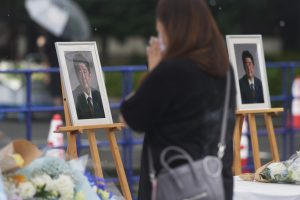At a press conference on July 14, Japanese Prime Minister Kishida Fumio announced that he would hold a state funeral – funded entirely by the government – in order to mourn the loss of former prime minister Abe Shinzo, who was assassinated during a campaign event on July 8. Kishida said the intent was both to commemorate Abe’s legacy, and to show Japan’s resolve that its democracy will not yield to violence. Following this announcement, Kishida made a cabinet decision to schedule Abe’s state funeral for September 27 this year.
The announcement was singular considering that no state funeral has been arranged since the death of Yoshida Shigeru, who was prime minister during the immediate aftermath of Japan’s military defeat in the Pacific War and successful in reclaiming Japanese independence in 1952. The decision made by then-Prime Minister Sato Eisaku was controversial at that time due to the fact that the legal basis for such an event is unclear. After Yoshida’s state funeral, the general precedent has been for the ruling Liberal Democratic Party (LDP) and the government to work cooperatively to mourn the loss of national leaders, where the LDP and the government co-organize a funeral, with a portion of the ritual supplemented by public funds.
The Japanese government’s avoidance of state funerals since Yoshida is seen as a measure to diffuse fierce public reaction against the state commemorating political figures and dodge criticisms that the state is infringing upon the principle of separation of church and state, taking into account the religious nature of funerals.
The State Funeral Order, issued as an edict to formally legalize the ritual in 1926, was nullified during the U.S. occupation, which aimed to democratize Japan and abolish militaristic elements from the society. The origin of this state funeral, according to Professor Miyama Jyunichi of Chuou University, could be found in the early days of Meiji Japan. Miyama says that the purpose of having a state funeral in the first place was for the Meiji government officials – mostly young, lower-class samurais – to reinforce their grip on power after the violent ouster of the Tokugawa shogunate government. In that context, enlisting the nation in national mourning was an effective way to demonstrate the accomplishments of the fallen luminaries of the newly established government, while suppressing dissenting voices that might challenge their fragile foundation of power.
Although some pundits have connected Kishida’s decision to hold a state funeral to a desire to appease conservatives, an article from Asahi indicates that Kishida personally was in favor. Shocked by the sudden death of Abe, who entered the Diet the same year as Kishida and tapped Kishida as his chief diplomat for nearly five years, Kishida was reportedly leaning toward a state funeral almost immediately and ordered his subordinates to look into the legal issues a few days after Abe was assassinated.
However, despite Kishida’s determination, the public seems to be divided on whether the Japanese government should host a state funeral for Abe. A poll from NHK showed that while 49 percent supported it, 38 percent opposed it. According to another poll released by FNN, 50.1 percent of the respondents answered that they were for the state funeral, while 46.9 percent were against it. In both the NHK and FNN polls, there was a distinct divide along generational lines, with people in their 20s being the most supportive of a state funeral while the elders reject it.
After the Kishida cabinet decision greenlighting a state funeral, nearly 200 protesters raised their voices, chanting “Oppose the cabinet decision” and “Don’t romanticize Abe’s politics,” revealing the deep animosity against the former prime minister.
The substantial opposition and intense backlash, indicated by both polling and street protests, indicates that Abe continues to be a polarizing individual in Japanese politics, potentially dividing the nation even without his presence. Abe’s reluctance to engage in constructive dialogue with his critics and his haste and zeal to transform Japan to become a U.S.-like security state – resulting in the passage of controversial legislation – in order to enhance his country’s security in a severe environment, evoked hatred and fear on the opposing side, which is hard to reconcile.
In the following months, leading up to the actual state funeral expected in late September, the Japanese public will have to reckon with Abe Shinzo, a complicated figure who is both revered and resented, and the legacy he left behind. Even after the event takes place Abe will continue to be viewed as a controversial figure and suck the oxygen out of Japanese political conversation.
































